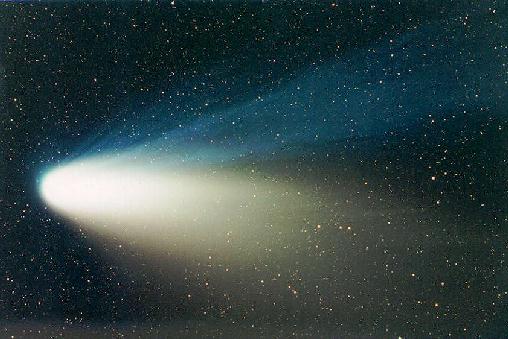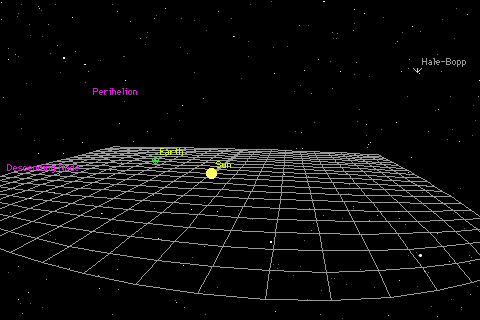

Comet Hale-Bopp has been called the "Comet of the Century". The spherical coma, at the left end, roughly 6 million Km in diameter, hides a 50-Km nucleus of ice and dust. As the comet approaches the Sun the ice vaporizes, releasing a cloud of gas and dust to produce the coma. The gas is light enough to be pushed directly away from the Sun by solar radiation, and is drawn out into an ion tail. The gas fluoresces blue as its atoms ionize and recombine. The more massive dust is also pushed away from the Sun into a dust tail, typically arched due to the dust's inertia.The dust reflects sunlight, and so appears yellow.

Comet Hale-Bopp was first observed on July 22, 1995 by amateur astronomers Alan Hale and Tom Bopp, when it was about 3.5 AU from the Sun. Its perihelion (closest approach to the Sun) of 0.9 AU occurred on April 1, 1997. In early May it crossed the plane of the ecliptic (the plane of the Earth's orbit), a position called the descending node. Its orbit is inclined at 89° to the ecliptic, and has an estimated period of 3400 years.
Find out more about Comet Hale-Bopp:
Here are some great close-up photographs of Comet Hale-Bopp, from the Astronomy Picture of the Day web site:
Cross your eyes for this one!
Here's another photo that clearly displays the separation of the two tails (ion blue; dust yellow-white):
Here's an animation of photographs taken over several days, which indicates the rotation of the nucleus (with a period of about 12 hours):
Comet Hale-Bopp was discovered on Saturday night July 22, 1995 by Alan Hale from Cloudcroft, New Mexico. His discovery was immediately followed about five minutes later by Tom Bopp from Phoenix, Arizona, giving them shared credit for the comet's discovery.
The comet was at that time in the constellation Sagitarrius and approximately 7.15 AU from Sun (about 665 million miles). A pre-discovery image was found on a photographic plate made by Robert McNaught at Siding Springs, Australia taken April, 27, 1993. At this time the comet was at 13.1 AU from the Sun. Possibly this is intrinsically the brightest comet in human history. Only the Great Comet of 1811 was a comparable object.
Comet Hale-Bopp is probably not a new comet from the Oort Cloud nor a visitor from the Kuiper Belt. Astronomers believe the comet made a close approach of 0.77 AU from Jupiter on April 5, 1996. This close approach changed its orbit from a period of 4,200 years down to a new period of 3,400 years. Donald K. Yeomans of the Jet Propulsion Lab has been searching the ancient records for any previous observation of this comet around circa 2,000 BC. At this time nothing has been found, although the comet should have been clearly visible. It should also be mentioned that the earliest comet we have records for is around 1059 BC and the next two are at 1002 BC and 974 BC. There is also a comet mentioned in Homer's Iliad but the date is very uncertain. However, of these comets were a thousand years too late. In effect, this comet has been here before and so all of its very volatile ices should have been sublimated off on its previous return. This would preclude it from being another comet Kohoutek or Austin, as both of these were Oort Cloud comets.
From all indications the comet should attain a magnitude of at least 0, and a magnitude of -2 (the brightness of the planet Jupiter) is not out of the question. As for tail length, we can only make rough guesses. It will in all likelihood be something around 10 or possibly 20 degrees in length. The comet will be highly foreshortened and so our best view of the tail structure will not come until several weeks after perihelion. However, the comet should appear somewhat more prominent than Hyakutake did but a lot smaller. We are currently awaiting anxiously the re-appearance of the comet after its conjunction with the Sun. When it emerges from the solar glare sometime during January, we should know then if the comet is going to produce the spectacle that is predicted for it.
In comparison, on Aug. 11, 1996, Comet Hale-Bopp was 3.475 AU from the Sun or 323,022,000 miles. On June 30, Comet Halley was at a comparable distance from the Sun. Comet Halley's magnitude on that date was 13.2, while Hale-Bopp at the same distance is at magnitude 5.2, which is 8.0 magnitudes difference. Currently Comet Hale-Bopp is running approximately 500 times brighter than Comet Halley when taking into account the difference between the Earth and both comets in relation to the distance to the sun.
Dr. Alan Hale was born in Japan in 1958 but moved with his family to Alamogordo, New Mexico later that year, where he lived until his graduation from high school in 1976. He then attended the U.S. Naval Academy in Annapolis, Maryland, and after graduating from there in 1980 with a Bachelor's Degree in Physics he was stationed at various assignments in San Diego and Long Beach, California. After getting out of the Navy in 1983 he worked for 2 1/2 years as an engineering contractor for the Deep Space Network at the Jet Propulsion Laboratory in Pasadena, California and was involved, among other projects, with the Voyager 2 encounter with the planet Uranus in 1986. Later that year he left JPL and returned to New Mexico in order to attend graduate school at New Mexico State University. He earned his Ph.D. in Astronomy from NMSU in 1992, and during the following year he founded and became Director of the Southwest Institute for Space Research. Now based in Cloudcroft, New Mexico, the Institute is an independent research organization which strives to enhance the scientific literacy of the general public by providing opportunities for direct participation in research programs and through other educational activities.
Dr. Hale's professional interests include the study of stars like the Sun and the search for other solar systems, including those which may contain planets similar to Earth, and he has authored several research papers in this field. He is also interested in the present efforts to identify potential Earth-impacting asteroids and comets, and is currently engaged in initiating a search program for these objects to be conducted from southern New Mexico and which will include participation by school students and the general public. At the same time, he is actively involved in the promotion of space exploration and the development of commercial space operations. In addition to all this work he has been an active amateur astronomer for most of his life and is a well-known observer of comets, having observed over 200 of these objects during the past 25 years. During the course of this endeavor he assisted the International Halley Watch during the return of Halley's comet in 1985-86, and was co-discoverer of Comet Hale-Bopp in July 1995.
In addition to his published research papers Dr. Hale has written numerous scientific articles for the general public. His articles have appeared in Astronomy, the Astronomical Calendar, Free Inquiry and Space News. He writes a weekly column on astronomy and space for the Alamogordo (NM) Daily News and occasionally writes articles for distribution by Singer Media Corporation. He has also recently authored Everybody' Comet: A Layman's Guide to Comet Hale-Bopp (High-Lonesome Books, 1996).
Dr. Hale presently resides in the Sacramento Mountains outside Cloudcroft, New Mexico, with his wife, two sons, and his dog and cat. When he is not engaged in his astronomical pursuits he enjoys hiking, running, swimming, listening to rock music, and watching football games.
Mr. Thomas Bopp was born in Denver, Colorado in 1949. Shortly thereafter his family moved to Youngstown, Ohio where as a young boy, his father taught him about meteor showers, constellations, the Aurora Borealis, and the planets. After finishing high school Mr. Bopp joined the Air Force and spent 18 months stationed in the Philippines where he was fortunate enough to witness the "Green Flash" on several occasions. Spending his last year in the service at Davis Monthan AFB in Tucson, Arizona, he met and married his wife, Charlotte. During his time in Tucson, he visited the Kitt Peak National Observatory and the Steward Mirror Lab at the University of Arizona.
Upon leaving the service, Mr. Bopp returned to Ohio and enrolled at Youngstown State University. While enrolled, he took an astronomy course along with business administration courses which were his major. During that time he met Dr. Warren Young, who introduced him to the Mahoning Astrological Society, an astronomy club in the Warren, Ohio area. As his particular area of interest is in deep space objects, Mr. Bopp put the club's 16" Newtonian telescope to good use with now-astronaut Ronald Praise.
In 1980, he took a new job in Phoenix, Arizona and moved there with his family. Attending meetings and observing with several astronomy clubs, Mr. Bopp didn't settle with any one group until he met his friend Jim Stevens, and was adopted into the "unofficial" North Phoenix Alternative Astronomical Society.
The Hale-Bopp animation was produced on a Macintosh with the Voyager II program, and is ©1988-93 Carina Software, 830 Williams St., San Leandro, CA 94577, (510) 352-7328. Used under license.
©1997 Scott R. Anderson